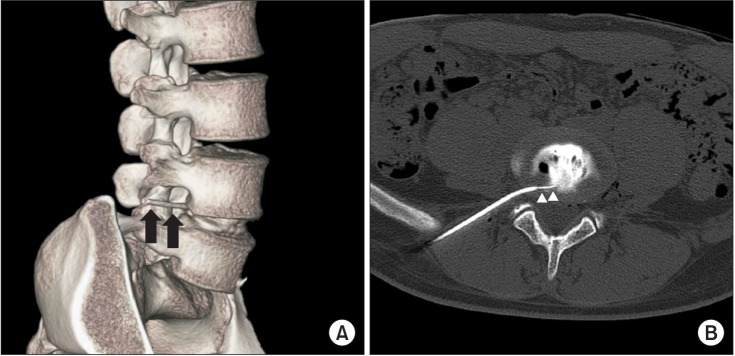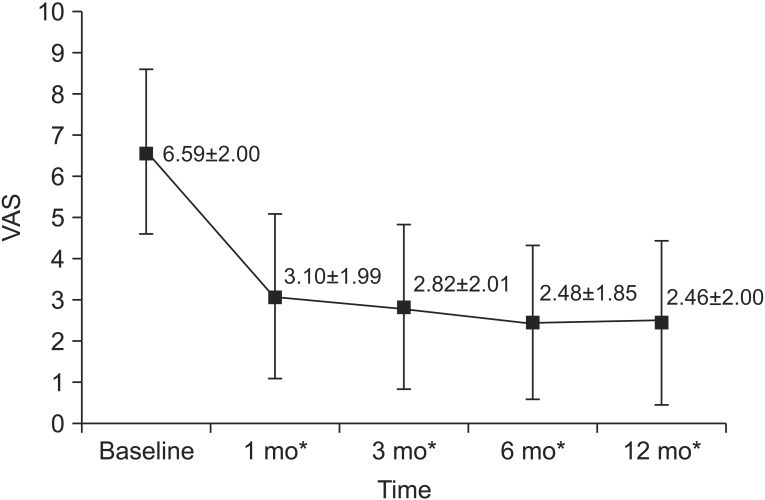Ann Rehabil Med.
2015 Oct;39(5):735-744. 10.5535/arm.2015.39.5.735.
The Factors Associated With the Successful Outcomes of Percutaneous Disc Decompression in Patients With Lumbar Herniated Nucleus Pulposus
- Affiliations
-
- 1Department of Physical Medicine and Rehabilitation, Korea University College of Medicine, Seoul, Korea. side_effect@naver.com
- KMID: 2148204
- DOI: http://doi.org/10.5535/arm.2015.39.5.735
Abstract
OBJECTIVE
To determine clinical and radiological factors that predict the successful outcome of percutaneous disc decompression (PDD) in patients with lumbar herniated nucleus pulposus (HNP).
METHODS
We retrospectively reviewed the clinical and radiological features of patients who underwent lumbar PDD from April 2009 to March 2013. Sixty-nine patients with lumbar HNP were studied. Clinical outcome was assessed by the visual analogue scale (VAS) and the Oswestry Disability Index (ODI). Multivariate logistic regression analysis was performed to assess relationship among clinical and radiological factors and the successful outcome of the PDD.
RESULTS
The VAS and the ODI decreased significantly at 1 year follow-up (p<0.01). One year after PDD, the reduction of the VAS (DeltaVAS) was significantly greater in the patients with pain for <6 months (p=0.03) and subarticular HNP (p=0.015). The reduction of the ODI (DeltaODI) was significantly greater in the patients with high intensity zone (p=0.04). Multivariate logistic regression analysis revealed the following 5 factors that were associated with the successful outcome after PDD: pain duration for <6 months (odds ratio [OR]=14.036; p=0.006), positive straight leg raising test (OR=8.425, p=0.014), the extruded HNP (OR=0.106, p=0.04), the sequestrated HNP (OR=0.037, p=0.026), and the subarticular HNP (OR=10.876, p=0.012).
CONCLUSION
PDD provided significant improvement of pain and disability of patients. The results of the analysis indicated that the duration of pain <6 months, positive straight leg raising test, the subarticular HNP, and the protruded HNP were predicting factors associated with the successful response of PDD in patients with lumbar HNP.
Keyword
MeSH Terms
Figure
Reference
-
1. Ong D, Chua NH, Vissers K. Percutaneous disc decompression for lumbar radicular pain: a review article. Pain Pract. 2014; 10. 29. [Epub]. DOI: 10.1111/papr.12250.
Article2. Kuslich SD, Ulstrom CL, Michael CJ. The tissue origin of low back pain and sciatica: a report of pain response to tissue stimulation during operations on the lumbar spine using local anesthesia. Orthop Clin North Am. 1991; 22:181–187. PMID: 1826546.3. Dewing CB, Provencher MT, Riffenburgh RH, Kerr S, Manos RE. The outcomes of lumbar microdiscectomy in a young, active population: correlation by herniation type and level. Spine (Phila Pa 1976). 2008; 33:33–38. PMID: 18165746.4. Brouwer PA, Brand R, van den Akker-van Marle ME, Jacobs WC, Schenk B, van den Berg-Huijsmans AA, et al. Percutaneous laser disc decompression versus conventional microdiscectomy in sciatica: a randomized controlled trial. Spine J. 2015; 15:857–865. PMID: 25614151.
Article5. Singh V, Piryani C, Liao K, Nieschulz S. Percutaneous disc decompression using coblation (nucleoplasty) in the treatment of chronic discogenic pain. Pain Physician. 2002; 5:250–259. PMID: 16902650.6. Lee SH, Derby R, Sul DG, Hong JW, Kim GH, Kang S, et al. Efficacy of a new navigable percutaneous disc decompression device (L'DISQ) in patients with herniated nucleus pulposus related to radicular pain. Pain Med. 2011; 12:370–376. PMID: 21332936.
Article7. Gerszten PC, Smuck M, Rathmell JP, Simopoulos TT, Bhagia SM, Mocek CK, et al. Plasma disc decompression compared with fluoroscopy-guided transforaminal epidural steroid injections for symptomatic contained lumbar disc herniation: a prospective, randomized, controlled trial. J Neurosurg Spine. 2010; 12:357–371. PMID: 20201654.
Article8. Karaman H, Tufek A, Olmez Kavak G, Yildirim ZB, Temel V, Celik F, et al. Effectiveness of nucleoplasty applied for chronic radicular pain. Med Sci Monit. 2011; 17:CR461–CR466. PMID: 21804466.
Article9. Charnley J. Orthopaedic signs in the diagnosis of disc protrusion: with special reference to the straight-leg-raising test. Lancet. 1951; 1:186–192. PMID: 14795816.10. Fardon DF, Milette PC. Combined Task Forces of the North American Spine Society. American Society of Spine Radiology. American Society of Neuroradiology. Nomenclature and classification of lumbar disc pathology. Recommendations of the Combined task Forces of the North American Spine Society, American Society of Spine Radiology, and American Society of Neuroradiology. Spine (Phila Pa 1976). 2001; 26:E93–E113. PMID: 11242399.11. Pfirrmann CW, Dora C, Schmid MR, Zanetti M, Hodler J, Boos N. MR image-based grading of lumbar nerve root compromise due to disk herniation: reliability study with surgical correlation. Radiology. 2004; 230:583–588. PMID: 14699183.
Article12. Pfirrmann CW, Metzdorf A, Zanetti M, Hodler J, Boos N. Magnetic resonance classification of lumbar intervertebral disc degeneration. Spine (Phila Pa 1976). 2001; 26:1873–1878. PMID: 11568697.
Article13. Aprill C, Bogduk N. High-intensity zone: a diagnostic sign of painful lumbar disc on magnetic resonance imaging. Br J Radiol. 1992; 65:361–369. PMID: 1535257.
Article14. Derby R, Lee SH, Kim BJ. Discography. In : Slipman CS, editor. Interventional spine: an algorithmic approach. Philadelphia: Saunders;2008. p. 291–302.15. Herkowitz HN, Garfin SR, Eismont FJ, Bell GR, Balderston RA. Rothman-Simeone the spine. 6th ed. Philadelphia: Elsevier Health Sciences;2011.16. Splendiani A, Puglielli E, De Amicis R, Barile A, Masciocchi C, Gallucci M. Spontaneous resolution of lumbar disk herniation: predictive signs for prognostic evaluation. Neuroradiology. 2004; 46:916–922. PMID: 15609071.
Article17. Erginousakis D, Filippiadis DK, Malagari A, Kostakos A, Brountzos E, Kelekis NL, et al. Comparative prospective randomized study comparing conservative treatment and percutaneous disk decompression for treatment of intervertebral disk herniation. Radiology. 2011; 260:487–493. PMID: 21613439.
Article18. Bokov A, Skorodumov A, Isrelov A, Stupak Y, Kukarin A. Differential treatment of nerve root compression pain caused by lumbar disc herniation applying nucleoplasty. Pain Physician. 2010; 13:469–480. PMID: 20859316.19. Woolf CJ, Doubell TP. The pathophysiology of chronic pain: increased sensitivity to low threshold Aβ-fibre inputs. Curr Opin Neurobiol. 1994; 4:525–534. PMID: 7812141.20. Jonsson B, Stromqvist B. Significance of a persistent positive straight leg raising test after lumbar disc surgery. J Neurosurg. 1999; 91(1 Suppl):50–53. PMID: 10419368.21. Knop-Jergas BM, Zucherman JF, Hsu KY, DeLong B. Anatomic position of a herniated nucleus pulposus predicts the outcome of lumbar discectomy. J Spinal Disord. 1996; 9:246–250. PMID: 8854281.
Article
- Full Text Links
- Actions
-
Cited
- CITED
-
- Close
- Share
- Similar articles
-
- Percutaneous LASER Disc Decompression for Lumbar Disc Herniations: Preliminary Report
- Histological Composition of the Extruded Intervertebral Disc in Lumbar Intervertebral Disc Herniation
- Sonographic evaluation of herniated lumbar disc
- Percutaneous Decompression of Intervertebral Disc Using Dekompressor(R): A case report
- Regression of Herniated Nucleus Pulposus after Anterior Interbody Fusion





